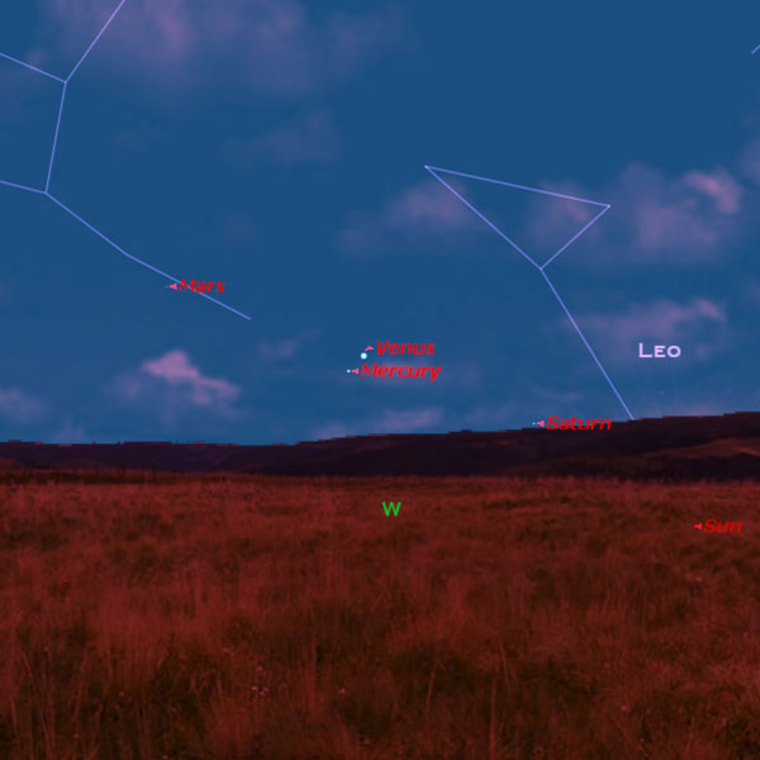The planet Venus passed conjunction with the sun on June 9 and is now emerging into view in the western evening sky. But it will be a long and tedious process. Even by the end of September this planet will still very low at dusk.
Look for Venus just as evening twilight fades, but don't wait too long, for it will set only about an hour after sunset. Scan just above the western horizon about 20 to 30 minutes after the sun goes down. Binoculars will certainly help you pick out Venus' silvery spark from the still-bright sky. As the season grows cooler Venus will slowly rise higher, until it shines as a brilliant "evening star" in the twilights of winter.
But Venus is currently not alone, for also nearby are the planets Mercury and Saturn.
Over the past week these three planets have been clustered rather closely together. Unfortunately, their close proximity to the sun caused these planet bunchings to be visible only with difficulty against the bright backdrop of evening twilight. They are still relatively close together this week, although all three are so very low to the western horizon and so deeply immersed in the bright sunset glow that it is debatable that — aside from Venus — that the other two planets will be observable.
Your best bet is to use binoculars and scan near the western horizon about 15 to 30 minutes after sunset.
Swap in Mars
In September, Saturn disappears into the fires of sunset and is replaced in the planet trio by Mars. So it will then be Venus, Mercury and Mars that will spend much of September tightly grouped together. Unfortunately, their proximity to the sun will continue to be a problem, so they'll continue to be visible only with difficulty against the bright backdrop of twilight.
Using binoculars and scanning the horizon somewhat to the south of due west about 15 to 30 minutes after sunset on Sept. 1, you just might be able to pick up Venus, Mercury and Mars forming a right triangle. And below and to the left of this planet trio will also be a narrow crescent moon just 2.1 days past new.
Viewers in the southern U.S. will have a bit of an advantage in that this group will appear a bit higher above the horizon.
Planet shuffles
On Sept. 7, the Venus-Mercury-Mars grouping will resemble an isosceles triangle, with the Mars-Mercury and Mars-Venus sides measuring about 2.5 degrees in length and the Mercury-Venus side about 4 degrees. And located about 10 degrees (roughly the width of your fist held at arm's length) to the upper left of the triangle will be Spica, the brightest star of the constellation Virgo.
Venus and Mars will be separated by only 0.3 degree (less than the apparent width of the moon) on Sept. 11. If you can locate Venus with binoculars in the twilight, Mars will be situated just below and to the left of Venus. Mars will appear only 1/174 as bright as dazzling Venus, so don't expect to see it right away.
The next evening, Venus is in conjunction with Mercury, but they're more widely separated at 3.6 degrees; Mercury will appear below and to the left of Venus. At magnitude +0.2, Mercury is much brighter than Mars, but still only 1/44 as bright as Venus. And creeping in from the east is Spica, about 7 degrees to the upper left of the three planets.
Come Sept. 18, Venus, Mercury and Mars will form an equilateral triangle, whose sides are 4 degrees in length. And Spica now becomes a part of this array, sitting only a few degrees to the left of the triangle. Whether you'll actually be able to see it, or the even fainter Mars against the backdrop of the bright twilight sky, however, is debatable.
But to have three planets and a bright star crammed into a relatively small spot in the sky does not happen very often, so I would urge you to give it a try.
